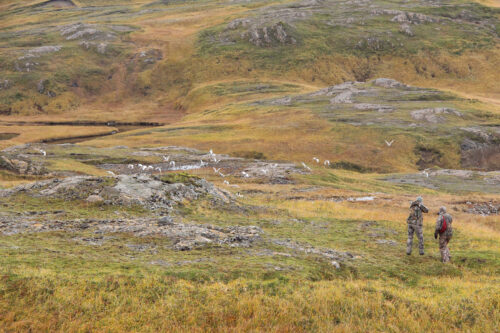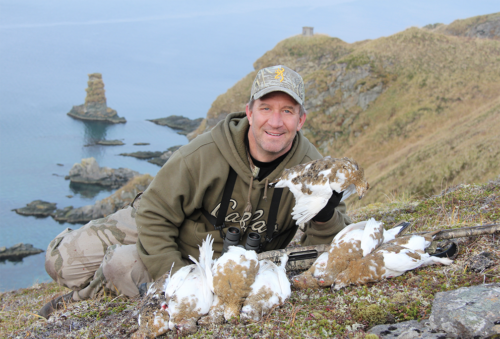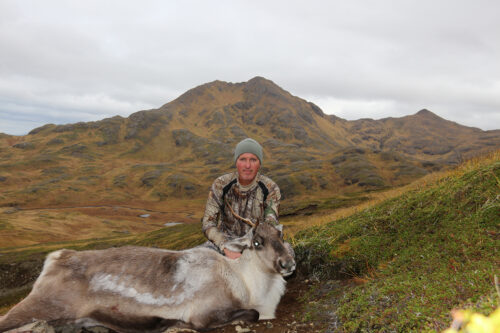
Hunting Birds, Big Game On Alaska’s ‘Ghost Island’
The following appears in the October issue of Alaska Sporting Journal:

BY SCOTT HAUGEN
Cresting a rolling hill with a brace of ptarmigan clutched between my fingers, the sudden beauty before me took my breath away. I’d been so focused on each step up the hill that I failed to realize the magnificent surroundings.
A calm bay with a rugged, rocky shoreline and a piece of history unveiled itself. I could only imagine what the bay must have looked like full of battleships, or how deafening the sound of war planes must have been as it echoed off the nearby mountains.
Once a booming military establishment with tens of thousands of people, including troops, Adak Island now looks like a ghost town. Walking the vacant streets, it’s not difficult to imagine what life here must have been like. Swing sets, still in good condition, lay dormant. The signs were gone on a centrally located restaurant, but it was clear it was once a McDonald’s.
Bowling pins could be seen here and there, signifying a popular pastime of residents. Standing where Franklin D. Roosevelt gave a speech to troops gave me goosebumps. In an old church, some hymnals were still perched in the backs of the pews.
The school was still operating but with very few children, for today only about 150 people call Adak home. But for hunters, the island is paradise, as is the case with much of remote Alaska.


PTARMIGAN GALORE
Over nearly a decade of living on the North Slope – where my wife Tiffany and I worked as school teachers in two remote villages – I enjoyed exceptional hunting. What the Arctic lacked in some species was made up for in others, and that’s what I quickly learned about Adak Island.
The first flock of ptarmigan I saw take wing from well over a mile away brought a smile to my face. When the birds landed, it was easy to see them – their white plumage stood out in stark contrast against the short, green vegetation. In fact, the low- growing plants afforded clear views for miles, making the hunting enjoyable throughout the island.
Joining me on the hunt were two buddies, Cory and Phil, both longtime Alaska residents. Both men are avid hunters and seasoned outdoorsmen, and we were all happy to be sharing time together – the first for all of us – on Adak.
Hiking in the hills south of town, finding ptarmigan was easy. It seemed every hilltop carried prime vegetation with thick berries. It was November and the weather was very mild, which is typical this far out on the Aleutians Chain. Adak is actually Alaska’s southernmost city, as well as the westernmost municipality in the United States.
The walking was easy, save for some dips and ridges to negotiate, and the ptarmigan thick. As we glassed the rolling tundra, we wouldn’t make a move until we spotted three or four flocks, all lined out. We’d move on one flock, pushing it toward the others when we shot. By the end of our hike, we’d have multiple birds to show for it. This repeated itself with virtually every stalk.
Thanks to their diet, the ptarmigan were very great-eating birds. Throughout the course of the week, Phil, Cory and I would hunt these birds a few more times. We enjoyed every moment.

CARIBOU MEAT HUNT
What initially brought us to Adak Island was the hunt for caribou. We anticipated big bulls and lots of animals. We experienced few animals and no bulls.
We’d missed the heyday of Adak caribou hunting, but we knew that going in. What we didn’t figure was that there would be so few animals, at least where we hunted.
We rented an Argo from a local, as well as a vacant home to stay in. As part of their agreement with the government, Alaska Airlines has regular weekly flights to the desolate island, so getting there is easy.
We soon discovered that ATV access to the public ground we could hunt was also diminishing due to excessive habitat damage. This meant we had to walk, and walk we did. We’d see a cow or two here and there, but no big herds, and nothing we really wanted to go after. We didn’t see a single bull. After a few days, we ran into some hunters from Southeast Alaska. They were packing out cows. When we asked them where all the bulls were, they came back with, “Bulls? Who wants bulls
when you have these great-eating cows,” a statement that came out rather matter of factly. “We come here every year just for the meat, and don’t think we’d shoot a bull even if we could,” smiled one man. “It’s the best-eating game in Alaska,” confirmed another.
It got us thinking and it made sense. First, here you have a group of residents from Alaska’s Panhandle who could get their fill of Sitka deer, yet they chose to come to Adak for their meat. Next, the island has no predators and the weather is mild by Alaska standards, both of which result in growing healthy caribou.
The fact we weren’t seeing many caribou just meant they were somewhere else. The more of Adak you hike, the more relief you discover in the deceptive land.
What appears flat from a distance could be very undulating, plus deep enough to hold thousands of caribou. Taking to the high ground and glassing was the norm. The goal was to spot a herd of caribou, then figure out a path to close the distance. This was easier said than done.
While we spotted a lot of singles and doubles, they were still caribou, meaning they covered ground deceptively fast. Just when you think you have them pegged, the caribou seem to vanish in the folding landscape. It’s like they knew we were there, but that was impossible, for the wind held consistent and they never did see us. Caribou are funny that way wherever I’ve hunted them throughout this state.
Finally, we caught a break. A herd of two dozen were spotted atop a mountain.

Doping the wind, we knew there was no way to get to them, so we had to wait for the caribou to make a move. They didn’t budge all day. The next morning they were still in the same place. Given the wind, there was no way we could get within shooting range of them.
Later that afternoon we passed by the herd again, still holding tight on the exposed precipice that gave them safety. Then, the herd arose and began walking before our eyes. We hurried as fast as we could, covering ground, hoping we were moving in the right direction. You don’t catch up to caribou on the move; you hope to intercept them.
We lost sight of the herd for a few minutes, and when we reached our designated checkpoint, they were nowhere to be seen. Suddenly, they popped out of the gully below less than 200 yards from where we sat.
With some quick shooting, soon we had three cows down, but there were no bulls in the herd. We each took a caribou to bone out, and shortly afterwards we were hauling out the meat on our backs. We’d all killed cows before and we all commented on how these were the biggest, fattest ones we’d ever seen.
That night we had fresh tenderloins for dinner. We had them for breakfast and dinner the next day too. Phil and I had eaten a lot of caribou over the years, as this was the primary meat of our semi-subsistence lifestyle. We both agreed these cows from Adak were the most delicious caribou we’d ever had. Caribou had made up most of our diet during the years my wife and I lived on the North Slope, and the Adak cow was the best she’s ever eaten too.

NO BULLS,NO PROBLEM
It was ironic; we were three men who’ve hunted all over Alaska and taken some magnificent trophy-class animals, and here we all were targeting cows. The experience captured what big game hunting in Alaska is mostly about: the meat. Travel to many villages throughout the state and you’ll see big moose racks, caribou racks and sheep horns tossed into piles outside homes rather than adorning the walls inside. Why? Because subsistence hunters hunt to put food on the table, not a trophy head on the wall.
Seemingly gone are the days of walking from the village of Adak and killing monster bull caribou on the edge of town. While they might wander by later in winter, if looking to go on this hunt, be prepared to spend long days afield, walking, glassing and packing. It’s likely going to be a meat hunt, too, and that’s not a bad thing; it’s reality.
Would I return to hunt Adak Island? You bet. The ptarmigan hunting alone is worth it, but next time I’m bringing my dogs because the terrain would suit them well, as long as no snow falls.
As for the caribou, I’d return there just for the quality of meat. It’s that good. ASJ
Editor’s note: For signed copies of Scott Haugen’s best-selling book, Hunting The Alaska High Arctic, visit scotthaugen.com. Follow Scott’s adventures on Instagram and Facebook.



